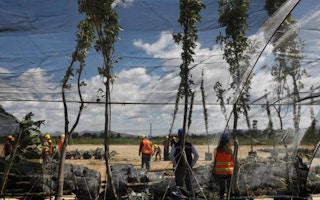Private investors are seeking to ramp up financing of projects that protect and restore nature this year but are struggling to find enough suitable deals, researchers said on Wednesday.
An analysis of conservation finance, led by Switzerland-based social enterprise South Pole, the Cornell Atkinson Center for Sustainability and the International Union for Conservation of Nature (IUCN), surveyed conservation project developers and large investors about their intentions.
It found that 70 per cent of financiers were planning to invest more in conservation in 2021 compared to 2020, but were struggling to find the right deals.
Project developers, meanwhile, aimed to raise 85 per cent more this year than in 2020.
Despite increased interest, small deal sizes, long horizons, high investment risks, low transparency on conservation impacts and a lack of bankable projects are preventing return-seeking investments in nature from scaling up, the report said.
“There is enough capital to address the biodiversity crisis,” said John Tobin-de la Puente, a professor at Cornell University.
“The bad news is that right now, there are just not enough investable financial products that will help deploy that capital,” he told the Thomson Reuters Foundation.
Improving conservation and management of natural areas, such as parks, oceans, forests and wildernesses, is seen as crucial to protecting the ecosystems on which humans depend and limiting global warming to internationally agreed targets.
Global annual spending to protect and restore nature on land needs to triple this decade to about $350 billion by 2030, a UN report said in May.
Investment in nature totalled $133 billion in 2020, it noted, with public funding making up 86 per cent and private finance the rest.
This year has seen some progress, with the launch of big new public-private initiatives like the Legacy Landscapes Fund for conservation areas, the LEAF coalition to fund emissions reductions from tropical forests and the Rimba Collective, a $1-billion effort to protect Southeast Asia’s forests.
French fashion house Chanel is also backing a new fund that aims to raise $100 million by 2025 to invest in sustainable projects in developing countries.
“We all thought a year ago - with Covid-19 breaking out - that no one cares anymore about nature as well as keeping profits … but the opposite has happened,” said Martin Stadelmann, head of climate investments at South Pole.
The pandemic and natural disasters linked to climate change have helped raise awareness about how the global economy is hugely dependent on biodiversity, he added.
Investment revolution
Conservation finance has historically relied on government grants and philanthropic funding.
The new report, which focused on private capital, found investors’ awareness of conservation finance opportunities had advanced in the past five years, leading to a surge in interest.
But a lack of publicly traded debt and equity in the nature sector means the financing costs for conservation are still much higher than for other sectors such as renewable energy, it said.
Of the individual conservation deals done in 2020, 85 per cent were reported to be under $5 million, with only 2 per cent above $51 million, the report added.
Primary revenue streams for conservation investments are sustainable commodities such as certified timber and fish at 55 per cent and environmental markets, including carbon credits, at 31 per cent.
A lack of a globally recognised standard for measuring conservation impacts from biodiversity investments is a barrier to investors, the report said.
The public sector could help build bankable project pipelines, de-risk private investments and create the right regulatory environment to encourage private investments into conservation, it added.
Public financial institutions could also help nature projects develop investable deals and assets, which can often be expensive and complicated, researchers said.
“Within this decade, we need to move from millions to trillions when it comes to financing nature,” said Elmedina Krilasevic, a programme coordinator at the IUCN.
“There is growing interest from policymakers and investors… (and) now is the time to power the nature investment revolution.”
This story was published with permission from Thomson Reuters Foundation, the charitable arm of Thomson Reuters, that covers humanitarian news, climate change, resilience, women’s rights, trafficking and property rights. Visit http://news.trust.org/climate.








